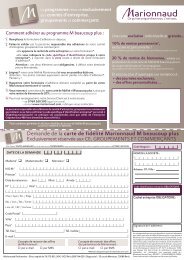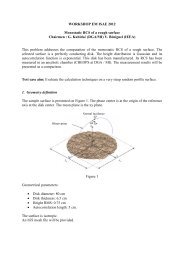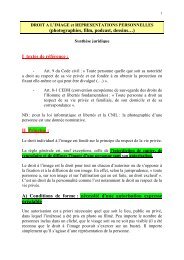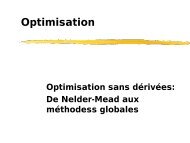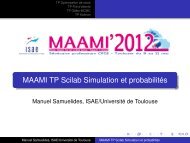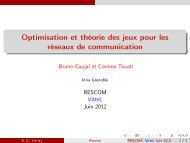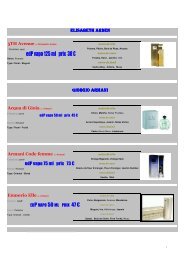Document
Document
Document
Create successful ePaper yourself
Turn your PDF publications into a flip-book with our unique Google optimized e-Paper software.
IPPW9 Short Course – Mass Spectrometers<br />
& Gas Chromatography<br />
Mass Spectrometers and Gas Chromatographs for<br />
Planetary Explora9on<br />
Paul Mahaffy, Will Brinckerhoff, and Stephanie Ge9y<br />
Planetary Environments Laboratory<br />
Solar System ExploraAon Division<br />
NASA Goddard Space Flight Center<br />
Paul.R.Mahaffy@NASA.gov<br />
InternaAonal Planetary Probe Workshop Short Course<br />
Toulouse, France<br />
June 17, 2012
Science quesAons addressed by mass<br />
spectrometers and gas chromatograph<br />
mass spectrometers<br />
Mass spectrometer types and how they<br />
work<br />
Chemical separaAon with<br />
chromatography<br />
Diverse chemical and physical<br />
environments<br />
IPPW9 Short Course – Mass Spectrometers<br />
& Gas Chromatography<br />
Examples – past, present, future exp’s<br />
• Galileo Probe Neutral Mass<br />
Spectrometer<br />
• Mars Science Laboratory Sample<br />
Analysis at Mars Instrument Suite<br />
• Mars Organic Molecule Analyzer<br />
developed for the ExoMars Mission<br />
• Two-‐Step Laser Tandem MS for<br />
Organics detecAon<br />
• Ultra-‐high mass resoluAon MS<br />
Probes with MS or GCMS<br />
instruments sent to Venus,<br />
Jupiter, Mars, & Titan
Mass spectrometers and gas chromatography can help get at some of the<br />
BIG PICTURE QUESTIONS IN PLANETARY EXPLORATION
Mass spectrometry – the basics<br />
• A mass spectrometer measures the mass-‐to-‐charge ra9o<br />
(m/z) of atoms and molecules in the gas phase<br />
• If your sample is not in the gas phase, you have to do<br />
something to vola9lize it<br />
– heat, spu9er, laser desorb, spray, even scratch! Also,<br />
pressure.<br />
• If your sample is not yet ionized you need to ionize it<br />
• Value of m/z used to iden9fy atoms and molecules<br />
– At “unit” mass resoluAon you can disAnguish any two<br />
species separated by 1 amu (or 1 Da), such as 12 C and 13 C<br />
– At higher mass resoluAon you can disAnguish species with<br />
the same “nominal” mass, such as CO and N 2 (~28 Da)<br />
– Peak intensiAes (I) ~ relaAve abundances; “Pa9ern” of I vs.<br />
m/z<br />
– The pa9ern of isotopes is a “fingerprint” of a species<br />
– The pa9ern of fragments is another “fingerprint”<br />
Ion source<br />
mass<br />
analyzer<br />
detector
Developed at NASA Goddard for<br />
• Comet Rendezvous Asteroid<br />
Flyby Mission<br />
• Cassini INMS<br />
• CONTOUR NGIMS<br />
• LADEE NMS<br />
• MAVEN NGIMS<br />
Example dual ion source with<br />
redundant W/3%Re filaments<br />
CONTOUR NGIMS with both OPEN and<br />
CLOSED source<br />
OPEN à for surface reacAve species<br />
CLOSED à for high sensiAvity for surface<br />
inert species
Example -‐ redundant channeltron<br />
pulse coun9ng detector<br />
Gain ~ 50 million
Type è<br />
êFeature<br />
Great Variety in Mass Analyzer Types<br />
Quadrupole (QMS) Ion Trap (ITMS) Time-‐of-‐Flight<br />
(TOF-‐MS)<br />
Scan Type Filter: one m/z at a<br />
time stable in AC<br />
field, passes to det.<br />
Ioniza9on<br />
Type(s)<br />
Mostly continuous<br />
(EI, ESI, ICP)<br />
Mass Range Lab: 1-2000+; Mini/<br />
Flight 1-500<br />
Mass Res.<br />
(typical)<br />
Typically unit (very<br />
low crosstalk)<br />
Spectrograph: Trap<br />
all ions in AC field,<br />
then scan out to det.<br />
Continuous (EI/ESI)<br />
or pulsed (laser)<br />
Lab: 50-4000;<br />
Mini/Flight: 50-1000<br />
Typically unit (can<br />
have high mass acc)<br />
Spectrograph: All<br />
ions reach det. at t<br />
~ (m/z) 1/2<br />
Mostly pulsed<br />
(laser, pulsed EI)<br />
Infinite (practically<br />
1 to ~10 kDa)<br />
From 10 2 to 10 5<br />
(path length & V)<br />
MS/MS? no yes (MS n ) yes (pseudo) no<br />
Planetary<br />
Examples<br />
Galileo/GPMS,<br />
Cassini/INMS,<br />
Huygens/GCMS,<br />
MSL/SAM, MAVEN/<br />
NGIMS<br />
Rosetta/Ptolemy,<br />
ExoMars/MOMA<br />
Rosetta/ROSINA-<br />
ROTF, Rosetta/<br />
COSAC, Phobos/<br />
LIMA-D (Phobos<br />
Grunt/LASMA)<br />
Sector MS<br />
Filter: one (or<br />
more) m/z in E-B<br />
field pass to det.<br />
Mostly continuous<br />
(EI, ICP)<br />
Several hundred<br />
(and up)<br />
Typically unit (very<br />
low crosstalk)<br />
Viking GCMS,<br />
Rosetta/ROSINA-<br />
DFMS, Beagle II/<br />
GAP, Phoenix/<br />
TEGA-MS
Hyperbolic Electrodes give field of form<br />
(x, y) = (V dc + V ac cos( t) (x 2 – y 2 )/R o 2<br />
Quadrupole MS<br />
Shown by Paul and Steinwedel [1953]<br />
that soluAons of the equaAons of moAon<br />
d 2 x/dt 2 + [V dc + V ac cos (t) 2ex/mR o 2 ] = 0<br />
d 2 y/dt 2 – [V dc + V ac cos (t) 2ey/mR o 2 ] = 0<br />
of a charged parAcle with mass m and charge e<br />
in this device -‐> to two types of soluAons stable<br />
and not stable. May use MULTIPLE frequencies.<br />
Dimensionless parameters<br />
a = 8eV dc /mR o 2 2<br />
q = 4eV ac /mR o 2 2 .
Example of double focusing MS<br />
Balsiger et al. (2007)<br />
With ion path<br />
perpendicular to<br />
magneAc field B<br />
m/q = B 2 r 2 M /(2U)<br />
Magnet can<br />
DISPERSE ions on<br />
focal plane<br />
One could change B<br />
or U but for flight<br />
applicaAon U is<br />
easier to change<br />
and a permanent<br />
magnet used to<br />
create B
Examples of 9me of flight MS<br />
Gio9o ParAculater Impact Analyzer (PIA)<br />
secured molecular and elemental<br />
composiAon measurements at comet<br />
Halley in 1986.<br />
Laser desorpAon resonance ionnizaAon<br />
mass spectrometer under development for<br />
Rb-‐Sr in situ daAng on the moon or Mars.<br />
S. Anderson et al.<br />
Reflectron figure – Co9er et al., 1999
Two-‐Step Laser Tandem MS<br />
for In Situ Organics Detec9on<br />
11-‐PIDD11-‐0044 -‐ Geby, Brinckerhoff, Cornish, Ecelberger, Callahan, Elsila, Zare, Yu, Trainer
Two-‐Step Laser Tandem MS<br />
for In Situ Organics Detec9on<br />
Development of a highly capable two-‐step laser tandem mass spectrometer (L2MS) opAmized to<br />
study the diversity and structure of nonvolaAle organics in solid samples on missions to outer<br />
planetary satellites and small bodies. The L2MS combines mulAple laser pulses and a precision<br />
ion gate to enable both post-‐ionizaAon of organics and tandem analysis of dissociaAon products<br />
to achieve tunable selec8vity and sensi8vity.<br />
1. Infrared matrix assisted laser desorpAon/ionizaAon (IR MALDI) to<br />
significantly increase the sensiAvity to the parent ions of high molecular<br />
weight organics in complex samples, especially those with water ice<br />
matrices where sample preparaAon would not be required;<br />
2. Two-‐step laser desorpAon/ionizaAon with maximal detecAon selecAvity<br />
for aromaAc organics via ultraviolet resonance-‐enhanced mulAphoton<br />
ionizaAon (UV REMPI); and<br />
3. Tandem mass spectrometry, or MS/MS, to reduce the intrinsic<br />
complexity of indiscriminate laser ionizaAon by selecAvely isolaAng and<br />
fragmenAng parent ions in the TOF-‐MS flight tube with photo-‐induced<br />
dissociaAon (PID) and precision gaAng.
• Leverage reversible-‐<br />
polarity TOF-‐MS<br />
development<br />
• AddiAonal features/<br />
capabiliAes:<br />
– 3 um pulsed primary<br />
laser (OPO)<br />
– 266 nm ionizaAon pulse<br />
– 266 nm<br />
photodissociaAon pulse<br />
– Cooled sample stage for<br />
measuring doped ices<br />
L2MS Instrument Design<br />
11/07/12 PIDDP Kickoff 13
Preliminary L2MS Demonstra9on:<br />
Pyrene Standard
Preliminary L2MS Demonstra9on:<br />
Meteori9c Extracts
Precision Ion Ga9ng<br />
• Pulsed ion gate can select a peak of interest, rejecAng dominant ions that<br />
obscure minor species<br />
• For parent species that dissociate easily, the parent mass and its product ions<br />
can be detected in one measurement in pseudo-‐tandem MS
Detector<br />
Quadrupole and Ion Trap MS<br />
SAM<br />
Quadrupole MS<br />
Hyperbolic Rods<br />
GC Effluent<br />
One m/z value passes through rods to<br />
detector at given set of rod voltages;<br />
spectrum formed by scanning voltages.<br />
MOMA<br />
Linear Ion Trap MS<br />
EI Source Hyperbolic Rods EI Source<br />
Laser<br />
Ions<br />
p < 10 -‐6 torr p < 10 -‐3 torr<br />
Detector GC Effluent<br />
All ions over m/z range are trapped in field<br />
of rods; spectrum formed by exciAng ions<br />
radially to detector by scanning voltage.
Ultra-‐high resolu9on mass spectra<br />
gives exact chemical composi9on<br />
Hu, Makarov et al. (2005)
CF 3 +<br />
C 2 F 4 +<br />
C 2 F 5 +<br />
C 2 F 5 +<br />
C 3 F 5 +<br />
C 3 F 5 +<br />
C 3 F 7 +<br />
Example mass spectra<br />
C 4 F 9 +<br />
C 5 F 10 N +<br />
Parent<br />
Ion<br />
C 8 F 16 N +<br />
C 9 F 20 N +<br />
Full Scan MS<br />
C 12 F 24 N +<br />
Fragmentation of m/z 264
GC detector signal<br />
GCMS separa9on in 9me provides<br />
defini9ve molecular iden9fica9on<br />
Ame
Harsh environments encountered at and in<br />
transit to planetary systems<br />
Temperature<br />
• Venus surface 735 K<br />
• Mars surface 214 K<br />
• comet interior temperature 140 K<br />
Pressure<br />
• to 100 bar in the giant planets in future probes<br />
• Venus surface pressure 92 bar<br />
• Mars surface pressure 6.4 millibar<br />
Radia9on<br />
• magnetospheric heavy ions and electrons<br />
• cosmic ray protons and heavy ions<br />
• solar flare protons and heavy ions<br />
Vibra9on and transient loads<br />
• harsh launch environment<br />
• entry of Galileo Probe 107,000 miles/hour<br />
(230 g)<br />
Life9me<br />
• several months to many years<br />
(1960’s and 1970’s planetary<br />
spacecra| are sAll operaAng
Mo9va9on for improved mass spectrometer measurements<br />
at Venus is to address fundamental issues of terrestrial<br />
planetary forma9on and evolu9on<br />
The assignment<br />
• to make precise (be9er than 1 %) measurements of isotope raAos and accurate (5-‐10%)<br />
measurements of abundances of noble gas<br />
• to obtain verAcal profiles of trace chemically acAve gases from above the clouds all the way<br />
down to the surface<br />
The challenge for Venus<br />
probe mass spectrometry<br />
• 4 orders of magnitude pressure<br />
differenAal on track from above<br />
clouds to surface<br />
• trace species measured to<br />
parts per billion<br />
• 9 orders of magnitude<br />
difference between atmospheric<br />
pressure at surface and ion<br />
source pressure in mass<br />
spectrometer<br />
• 500 degree temperature<br />
gradient from atmosphere<br />
above clouds to surface<br />
• cloud droplets and aerosols<br />
that can clog mass spectrometer<br />
inlet systems and mask real<br />
verAcal variaAons due to their<br />
condensaAon on surfaces<br />
• a fast ride to the surface with<br />
an entry probe
Galileo Probe Neutral Mass<br />
Spectrometer
GPMS – each m/z tracked during<br />
~ 1 hour descent to 21 bar
GPMS spectrum from deep in<br />
Jupiter’s atmosphere<br />
Features of the quadrupole mass spectrometer<br />
• Dynamic range<br />
• Minimal crosstalk between unit mass channels
Mul9ple elemental and isotope<br />
ra9os measured by the GPMS
Curiosity con9nues the assessment of Mars Habitability<br />
Beyond signs of water, the rover will look for<br />
signs of organics, the chemical building blocks of life.<br />
“Follow the<br />
Carbon”<br />
Ar8st’s Concept.<br />
NASA/JPL-‐Caltech
While slowing down using the parachute, the<br />
heat shield is popped off, exposing the rover to<br />
the Martian atmosphere.<br />
The rover’s descent camera begins taking a movie of the<br />
remaining five-mile flight to the ground.<br />
Ar8st’s Concept. NASA/JPL-‐Caltech
The engines on the descent stage roar to life<br />
and fly the rover down the last mile to the surface.<br />
As it descends, the rover uses radar to measure its speed and al9tude, which<br />
it uses to land safely.<br />
Ar8st’s Concept. NASA/JPL-‐Caltech
The hovering descent stage lowers the rover<br />
on three nylon ropes called bridle.<br />
Coiled electronics and communications cables<br />
also unspool from the descent stage.<br />
This configuration is known as the “Sky Crane.” Ar8st’s Concept. NASA/JPL-‐Caltech
When the sky crane “senses” that Curiosity<br />
has touched down, the cables are cut.<br />
The sky crane flies a safe distance away<br />
from the rover before crash-landing.<br />
Ar8st’s Concept. NASA/JPL-‐Caltech
Curiosity being tested in the JPL clean room<br />
32
Viking à life on Mars? MER à follow the water<br />
Objec9ves include:<br />
MSL mission goals<br />
MSL à find the carbon<br />
Curiosity’s primary scien3fic goal is to explore and<br />
quan3ta3vely assess a local region on Mars’ surface as a<br />
poten3al habitat for life, past or present<br />
• Assessing the biological potenAal of the site by invesAgaAng any organic and<br />
inorganic compounds and the processes that might preserve them<br />
• Characterizing geology and geochemistry, including chemical, mineralogical, and<br />
isotopic composiAon, and geological processes<br />
• InvesAgaAng the role of water, atmospheric evoluAon, and modern weather/<br />
climate<br />
• Characterizing the spectrum of surface radiaAon
5.4 o S 137 o E<br />
Gale Crater<br />
Mount Sharp<br />
~ 154 km<br />
5.5 km mound
Sample Analysis at Mars Instrument<br />
Suite – including GCMS<br />
SAM suite instruments and major subsystems<br />
• Quadrupole Mass Spectrometer<br />
• 6-‐column Gas Chromatograph<br />
• 2-‐channel Tunable Laser Spectrometer<br />
• Gas Processing System<br />
• Sample ManipulaAon System<br />
GC<br />
TLS<br />
QMS<br />
SMS
Organic<br />
compounds<br />
of bio9c<br />
relevance<br />
Targeted<br />
organics<br />
(amino<br />
acids etc.)<br />
CO 2 , CH 4<br />
and H 2 O<br />
variability<br />
& isotopes<br />
SAM Science Goal<br />
Sources &<br />
destruc9on<br />
paths for<br />
organics<br />
PAST OR PRESENT<br />
HABITABILITY OF MARS<br />
assessment includes<br />
INVENTORY OF ORGANIC<br />
COMPOUNDS<br />
CHEMICAL, ISOTOPIC, &<br />
MINERALOGICAL COMPOSITION<br />
Trace species &<br />
atmos/surf ace<br />
interac9ons<br />
SAM Measurement<br />
Organic<br />
compound<br />
inventory<br />
Noble gas<br />
abundance<br />
& isotopes<br />
Chemical<br />
state of<br />
light<br />
elements<br />
Atmospheric<br />
evolu9on<br />
Evolved gas<br />
analysis<br />
(CO 2 , SO 2 ,<br />
H 2 O etc.)
Gas flow diagram -‐ simplified
SAM INSTRUMENT SUITE OVERVIEW<br />
Gas and solid sample manipulaAon<br />
microvalve<br />
Sample manipulaAon<br />
oven<br />
chemical<br />
ge9er
The SAM Tunable Laser Spectrometer<br />
developed by Webster/JPL
The SAM Tunable Laser Spectrometer<br />
line selec9ons
QMS characterisAcs<br />
• precision assembly hyperbolic rods<br />
• Atanium alloy housing<br />
• in situ bakeout<br />
• 3 frequency RF<br />
• pressurized enclosure for RF<br />
electronics<br />
• 2-‐535 Da<br />
• dual electron guns<br />
• dual detectors<br />
• 2 direct atmosphere inlets<br />
• 6 gas chromatograph inlets<br />
SAM Quadrupole Mass<br />
Spectrometer (QMS)
SAM 6 column gas chromatograph
SAM 6 column gas chromatograph
SAM 6 column gas chromatograph<br />
Injec9on trap and heat pipe
Inlet and outlet<br />
Capillaries<br />
SAM 6 column gas chromatograph<br />
Thermal conduc9vity detectors
GC TCD detectors<br />
obtained on the SAM<br />
flight unit during<br />
calibra9on and<br />
environmental tes9ng<br />
SAM 6 column gas chromatograph<br />
GCMS spectra<br />
obtained on the SAM<br />
flight unit during<br />
calibra9on and<br />
environmental tes9ng
Solid Sample Inlet Tube<br />
(~ 0.5 g soil dropped to cup)<br />
MTBSTFA: N-(tertbutyldimethylsilyl)-Nmethyltrifluoroacetamide<br />
O<br />
F Si<br />
F<br />
F<br />
N<br />
DMF: Dimethylformamide<br />
O N<br />
TMAH: Tetramethylammonium hydroxide<br />
N +<br />
OH -<br />
MeOH: Methanol<br />
OH<br />
SAM Derivatization Experiment<br />
Sample Carousel (74 cups total, 9 derivatization)<br />
1<br />
2 3<br />
4 5 6 7<br />
MTBSTFA/DMF (7 cups)<br />
TMAH/MeOH (2 cups)<br />
8<br />
9<br />
10.8 cm
SAM test, qualification, and calibration<br />
Runs with and without cup preconditioning gives<br />
residual contamination level in SMS
Foil cap<br />
Foil cap<br />
Pinch-off<br />
tubes<br />
Derivatization Chemistry<br />
Contents of Derivatization Cups:<br />
Outer volume:<br />
0.5 ml MTBSTFA/DMF (4:1) or<br />
TMAH/MeOH (1:3)<br />
25 nmol pyrene (in solution)<br />
Solvent degassed by 3 freezepump-thaw<br />
cycles<br />
Inner volume (Internal standard):<br />
40 nmol 3-Fluoro-DL-valine<br />
(MTBSTFA) or 13 nmol Nonanoic<br />
acid (TMAH)<br />
F<br />
NH 2<br />
O<br />
OH<br />
3-Fluoro-DL-valine<br />
Pyrolysis<br />
Oven<br />
Volatiles to<br />
trap/GC<br />
tert.-‐butyl-‐dimethylsilyl-‐N-‐methyltrifluoroacetamide (MTBSTFA) and dimethylform-‐amide (DMF)<br />
tetramethylammonium hydroxide<br />
pyrene<br />
N +<br />
OH- OH<br />
MeOH<br />
O<br />
R +<br />
Pyrolysis<br />
R + NH3 O<br />
derivatization agent (TMAH)<br />
unknown carboxylic acid<br />
O<br />
derivatized product<br />
O<br />
OH<br />
Nonanoic acid
Organic check material<br />
• Amorphous silica with about 30%<br />
porosity<br />
• Compressibility about 12 MPa<br />
• Doped with fluorinated<br />
compounds<br />
Organic Check Material<br />
OCM Bricks<br />
In flight calibrants<br />
• Fluorinated compounds present<br />
both in calibraAon cell and in<br />
selected sealed cups
SAM measurement modes<br />
On board command SCRIPTS control each sequence
Calibra9on of the SAM Flight Model
SAM test, qualification, and calibration<br />
During thermal qualification core sequences were exercised with mixture<br />
of calcite, heptahydrate melanterite, and fluorocarbons on inert silica glass<br />
or for volatile species introduced to the SAM hydrocarbon trap.<br />
CaCO 3 (s) à CaO (s) + CO 2 (g) DetecAon limit esAmated to be ~10 microgram<br />
54
SAM test, qualification, and calibration<br />
During thermal qualification core sequences were exercised with mixture<br />
of calcite, heptahydrate melanterite, and fluorocarbons on inert silica glass<br />
CONTINUED DATA ANALYSIS ON-GOING<br />
DetecAon limit esAmated to be ~200 nanogram<br />
FeSO 4 .7H 2 O à evolved SO 2 + H 2 O<br />
55
Bringing a Chemical Laboratory Named<br />
Sam to Mars on the 2011 Curiosity Rover
High fidelity SAM testbed used in high fidelity<br />
environment to test measurement sequences prior to<br />
radiaAng them to SAM on Curiosity
Mars Organic Molecule Analyzer -‐<br />
MOMA
MOMA-MS is the Goddardprovided<br />
central mass<br />
spectrometer and electronics<br />
subsystem of MOMA.<br />
MOMA Investigation on ExoMars 2018<br />
Principal Investigator: Fred Goesmann, MPS<br />
MOMA directly addresses the top in situ science goal of ExoMars<br />
to seek the signs of past or present life on Mars.<br />
MOMA is a dual-source mass spectrometer-based investigation of<br />
organic molecules in Mars samples. The concentration, structure,<br />
and distribution patterns of organics can be indicators of life.<br />
Laser Head<br />
Wide Range Pump<br />
(hidden)<br />
ExoMars Analytical Laboratory Drawer (ALD) includes MOMA<br />
Out-of-Date<br />
ALD Model<br />
Secondary<br />
Electronics Box
Why an ion trap for MOMA?<br />
Selection of the ion trap for the MOMA project:<br />
1. ability to interface with two external ionization sources<br />
including one at elevated (Mars) pressures (5-7 Torr)<br />
2. ability to carry out tandem mass spectrometry or MS/MS<br />
a. provide definitive ID of organic compounds<br />
b. distinguish structural isomers<br />
c. peak in MS spectrum used to designate the precursor<br />
mass in subsequent MS/MS spectrum<br />
4/18/2012 BriAsh Mass Spectrometry Society MeeAng 2012 60
Detector<br />
SAM<br />
Quadrupole MS<br />
Hyperbolic Rods<br />
GC Effluent<br />
One m/z value passes through rods to<br />
detector at given set of rod voltages;<br />
spectrum formed by scanning voltages.<br />
Separated at Birth<br />
MOMA<br />
Linear Ion Trap MS<br />
EI Source Hyperbolic Rods EI Source<br />
Laser<br />
Ions<br />
p < 10 -‐6 torr p < 10 -‐3 torr<br />
Detector GC Effluent<br />
All ions over m/z range are trapped in field<br />
of rods; spectrum formed by exciAng ions<br />
radially to detector by scanning voltage.<br />
Heritage spaceflight QMS design readily translates to linear ion trap!
Mars<br />
sample<br />
on a<br />
plate<br />
Mars ambient<br />
5-‐7 torr ~CO 2<br />
MOMA-‐MS:<br />
Dual Source Ion Trap Mass Spectrometer<br />
1a. Pulsed UV laser<br />
desorpAon/ionizaAon<br />
1b. Ions drawn<br />
into capillary<br />
ion guide tube<br />
1c. LDMS ion<br />
introducAon<br />
1d. Aperture Valve<br />
closes off tube a|er<br />
ions captured<br />
Linear ion trap<br />
Detectors<br />
~10 cm (a very small mass spectrometer!)<br />
2. External<br />
electron impact<br />
ion source<br />
GCMS ion<br />
introducAon<br />
Effluent from the gas<br />
chromatograph
MOMA-‐MS Breadboards and Flight Design<br />
FLT-scale GB2 linear ion trap Mounted ion trap and detectors<br />
• Latest breadboard demonstrates dual LIT<br />
performance at miniaturized Flight Scale<br />
• Fast aperture valve enables LDI in the<br />
discontinuous API (DAPI) regime<br />
• Ion trap analysis from French GC and<br />
German laser: end-to-end MOMA science<br />
Scan Speed ≈ 4150 amu/sec<br />
Mass resolution<br />
0.3 amu FWHM<br />
EI-ITMS of PFTBA test<br />
compound in He<br />
LDI at Mars<br />
ambient 5-7 torr<br />
using fast valve!<br />
GC gas valve<br />
manifold<br />
FM Concept<br />
Laser<br />
MS Housing<br />
Laser<br />
Conduit<br />
Creare 200k<br />
rpm pump<br />
RF Power<br />
Supply<br />
RF HV Conduit<br />
Aperture Valve<br />
Solenoid<br />
Aperture Valve<br />
Detail Cutaway<br />
Sample Position<br />
Thermo LTQ<br />
(Commerical)
Breadboard “GB1” using<br />
Commercial LIT (LXQ or LTQ)<br />
• r 0 = 4 mm<br />
• Length = 63 mm<br />
• RF frequency = 700-‐900 kHz<br />
• Max RF voltage = 2000 Vpp<br />
1 cm<br />
Trap Designs Under Test<br />
1 cm<br />
Breadboard “GB2” using<br />
custom/miniature LIT<br />
• r 0 = 3mm<br />
• Length = 28 mm<br />
• 25% of the LTQ volume<br />
• RF frequency = 700 kHz<br />
• Max RF voltage = 1000 Vpp<br />
Opera9onal parameters chosen to op9mize<br />
performance under FLT power and mass requirements.<br />
1 cm<br />
1 cm
C 2 F 5 +<br />
C 3 F 5 +<br />
Resolu9on Performance<br />
GB1 Breadboard (LTQ electrodes)<br />
0.5 amu<br />
C 5 F 10 N +<br />
EI -‐ PFTBA<br />
x 10<br />
C 8 F 16 N +<br />
GB1 with RF Breadboard Supply<br />
C 9 F 20 N +
CF 3 +<br />
C 2 F 5 +<br />
C 2 F 4 +<br />
Resolu9on Performance – GB2<br />
C 3 F 5 +<br />
EI -‐ PFTBA<br />
0.35 amu<br />
C 5 F 10 N +<br />
C 8 F 16 N +<br />
4/18/2012 BriAsh Mass Spectrometry Society MeeAng 2012 66
C 2 F 4 +<br />
0.09 amu<br />
EI Mass Range and Calibra9on<br />
C 3 F 5 +<br />
0.01 amu<br />
EI -‐ PFTBA<br />
C 5 F 10 N +<br />
-0.11 amu<br />
C 8 F 16 N +<br />
-0.16 amu<br />
Average Error = 0.12 amu<br />
C 9 F 20 N +<br />
0.17 amu<br />
4/18/2012 BriAsh Mass Spectrometry Society MeeAng 2012 67
LDI Mass Range<br />
and Calibra9on– GB2<br />
[CHCA+H]<br />
Error = 0.25 amu<br />
LDI – Angiotensin II<br />
[2xCHCA+H]<br />
Error = -‐0.32 amu<br />
Average Error = 0.24 amu<br />
[M+H] + = m/z 1045<br />
Error = 0.07 amu<br />
4/18/2012 BriAsh Mass Spectrometry Society MeeAng 2012 68
32<br />
38<br />
40<br />
EI Low Mass – GB2<br />
42<br />
CharacterisAc hydrocarbon clusters observed<br />
** precise calibraAon in quesAon at these low masses **<br />
53 55<br />
Trapping of low masses possible with stable low RF voltages from RF breadboard<br />
4/18/2012 BriAsh Mass Spectrometry Society MeeAng 2012 69<br />
67
MS & MS/MS - ink standard<br />
MOMA: AGM, March 2012<br />
http://www.hopkinsmedicine.org/mams/
Future Opportuni9es for Planetary<br />
Probe Mass Spectrometers<br />
Saturn: 2011 NRC Planetary Decadal Study<br />
Key science themes:<br />
– Constrain models of solar system formaAon<br />
and the origin and evoluAon of atmospheres<br />
– Provide a basis for comparaAve studies of the<br />
gas and ice giants<br />
– Provide a link to extrasolar planetary systems<br />
“The Saturn Probe mission will make important<br />
contribuAons to addressing giant planet goals in the<br />
period 2013-‐2022 by providing measurements of noble<br />
gas abundances that can be obtained in no other way<br />
and, thus, placing Saturn into context relaAve to<br />
Jupiter and the Sun.” Vision and Voyages for Planetary<br />
Science in the Decade 2013-‐2022.<br />
Titan Mare Explorer – TiME<br />
Would explore the<br />
chemical composi9on<br />
of a cryogenic<br />
extraterrestrial sea



